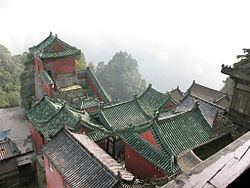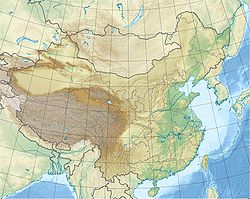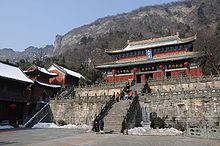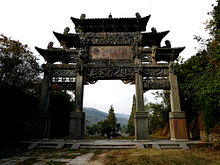- Wudang Mountains
-
This article is about the Wudang region in Hubei, China. For other uses, see Wu-Tang (disambiguation).
Ancient Building Complex in the Wudang Mountains * UNESCO World Heritage Site
Country China Type Cultural Criteria i, ii, vi Reference 705 Region ** Asia-Pacific Inscription history Inscription 1994 (18th Session) * Name as inscribed on World Heritage List
** Region as classified by UNESCOThe Wudang Mountains (simplified Chinese: 武当山; traditional Chinese: 武當山; pinyin: Wǔdāng Shān, pronounced [ùtɑ́ŋ ʂán]), also known as Wu Tang Shan or simply Wudang, are a small mountain range in the northwestern part of Hubei Province of People's Republic of China, just to the south of the city of Shiyan.
Contents
Geography
On Chinese maps, the name "Wudangshan" (武当山) is applied both to the entire mountain range (which runs east-west along the southern edge of the Hanshui River valley, crossing several county-level divisions of Shiyan Prefecture-level city), and to the small group of peaks located within Wudangshan Jiedao of the Danjiangkou County-level City of the Shiyan Prefecture-level city. It is the latter specific area which is known as a Taoist center.[1]
Modern maps show the elevation of the highest of the peaks in the Wudang Shan "proper" as 1612 meters;[1][2] however, the entire Wudangshan range has somewhat higher elevations elsewhere.[1] Some consider the Wudang Mountains to be a "branch" of the Daba Mountains range,[2] which is a major mountain system of the western Hubei, Shaanxi, Chongqing and Sichuan.
History
In years past, the mountains of Wudang were known for the many Taoist monasteries to be found there, monasteries which became known as an academic centre for the research, teaching and practice of meditation, Chinese martial arts, traditional Chinese medicine, Taoist agriculture practices and related arts. As early as the Eastern Han Dynasty (25–220 AD), the mountain attracted the Emperor's attention. During the Tang Dynasty (618–907), the first site of worship—the Five Dragon Temple—was constructed. Some of the monasteries were damaged during and after the Cultural Revolution of 1966–1976, but the Wudang mountains have lately become increasingly popular with tourists from elsewhere in China and abroad due to their scenic location and historical interest. The monasteries and buildings were made a UNESCO World Heritage Site in 1994. The palaces and temples in Wudang, contains Taoist buildings from as early as the 7th century,[3] and the largest groups of complex on the mountain was built during the Ming Dynasty (14th–17th centuries).[3] It represents the highest standards of Chinese art and architecture over a period of nearly 1,000 years. Noted temples include the Golden Hall, Nanyan Temple and the Purple Cloud Temple.
On January 19, 2003, the 600-year-old Yuzhengong Palace at the Wudang Mountains was accidentally burned down by an employee of a martial arts school.[4] A fire broke out in the hall, reducing the three rooms that covered 200 square metres to ashes. A gold-plated statue of Zhang Sanfeng, which was usually housed in Yuzhengong, was moved to another building just before the fire, and so escaped destruction in the inferno.[5]
Association with martial arts
According to legend,[clarification needed] Zhang Sanfeng (张三丰), is the originator of Wudangquan generally and Taijiquan specifically. He was said to be inspired by a fight he witnessed between a pied magpie (also said to be a white crane) and a viper.
From the early 20th century, Taijiquan, Xingyiquan and Baguazhang have been considered Wudang styles, following Sun Lutang. Following this classification the national martial arts tournament of the Central Guoshu Institute held in 1928 separated the participants into "Shaolin" and "Wudang".
The third biannual Traditional Wushu Festival was held in Wudang Mountains from October 28 to November 2, 2008.[6]
Gallery
See also
- Tao Yin
- Wudang Sect
- Xuan Wu
- Yang Lu Chan
- Wu-Tang Clan
References
- ^ a b c Road Atlas of Hubei (湖北省公路里程地图册; Hubei Sheng Gonglu Licheng Dituce), published by 中国地图出版社 Zhongguo Ditu Chubanshe, 2007, ISBN 978-7-5031-4380-9. Page 11 (Shiyan City), and the map of the Wudangshan world heritage area, within the back cover.
- ^ a b "Wudang Mountains", Atlas of World Heritage: China, Long River Press, 2008, pp. 89–90, ISBN 1592650600, http://books.google.com/books?id=tFRgajxu3wIC&pg=PT99
- ^ a b Ancient Building Complex in the Wudang Mountains
- ^ "China's world heritage sites over-exploited". China Daily. December 22, 2006. http://www.chinadaily.com.cn/china/2006-12/22/content_765749.htm. Retrieved 2008-04-19.
- ^ Wang, Fang (May 11, 2004). "Pilgrimage to Wudang". Beijing Today. http://www.chinadaily.com.cn/english/doc/2004-05/11/content_329676.htm. Retrieved 2008-04-19.
- ^ 李, 鹏翔 (April 18, 2008). "第三届世界传统武术节将在湖北十堰举行". 新华社稿件. http://www.pladaily.com.cn/site1/xwpdxw/2008-04/18/content_1209982.htm#. Retrieved 2008-04-19.
Bibliography
- Pierre-Henry de Bruyn, Le Wudang Shan : Histoire des récits fondateurs, Paris, Les Indes savantes, 2010, 444 pp.
External links
- UNESCO World Heritage Sites descriptions
- International Wudang Federation (including training in Wudangshan)
- Wudang Global Federation
World Heritage Sites in China East Classical Gardens of Suzhou · Fujian Tulou · Lushan National Park · Mount Huang (Huangshan) · Mount Sanqing (Sanqingshan) · Mount Tai (Taishan) · Mount Wuyi (Wuyishan) · Temple and Cemetery of Confucius and Kong Family Mansion, Qufu · Ancient villages in Southern Anhui - Xidi and Hongcun · West Lake Cultural Landscape of Hangzhou
South Central Ancient Building Complex in the Wudang Mountains · Historic Centre of Macau · Kaiping Diaolou and Villages · Longmen Grottoes · Historic Monuments of Dengfeng, including the Shaolin Monastery and Gaocheng Observatory · Wulingyuan Scenic and Historic Interest Area · Yin Xu
Southwest Dazu Rock Carvings · Historic Ensemble of the Potala Palace, including the Jokhang and Norbulingka · Huanglong Scenic and Historic Interest Area · Jiuzhaigou Valley Scenic and Historic Interest Area · Old Town of Lijiang · Mount Emei Scenic Area, including Leshan Giant Buddha Scenic Area · Mount Qingcheng and the Dujiangyan Irrigation System · Sichuan Giant Panda Sanctuaries · Three Parallel Rivers of Yunnan Protected Areas
North Mount Wutai (Wutaishan) · Chengde Mountain Resort and its outlying temples including the Putuo Zongcheng Temple, Xumi Fushou Temple and the Puning Temple · Imperial Palaces of the Ming and Qing Dynasties in Beijing and Shenyang · Peking Man Site at Zhoukoudian · Ancient City of Pingyao · Summer Palace, an Imperial Garden in Beijing · Temple of Heaven: an Imperial Sacrificial Altar in Beijing · Yungang Grottoes
Northeast Capital Cities and Tombs of the Ancient Koguryo Kingdom · Imperial Palaces of the Ming and Qing Dynasties in Beijing and Shenyang
Northwest Multiple regions Hubei topics Wuhan (capital) General Geography Cities • Wudang Mountains • Jingshan Mountains • Daba Mountains • Shennongjia • Wu Mountains • Dabie Mountains • Mufu Mountains • Yangtze River • Han River • Three GorgesEducation Culture Cuisine Visitor attractions Jingzhou • Xianling Tomb (in Zhongxiang) • Yellow Crane Tower • Hubei Provincial Museum • Underground Project 131Coordinates: 32°24′03″N 111°00′14″E / 32.40083°N 111.00389°E
Categories:- Chinese martial arts
- Taoism
- Taoist temples in China
- Tai chi chuan
- World Heritage Sites in China
- Mountain ranges of China
- National parks of China
- Sacred mountains
- Geography of Hubei
- Visitor attractions in Hubei
Wikimedia Foundation. 2010.








